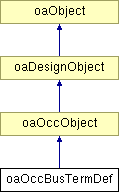oaOccBusTermDef Class Reference
Inheritance diagram for oaOccBusTermDef:

Detailed Description
The oaOccBusTermDef class defines an object that manages all oaOccBusTerms with the same base name in the module domain. An oaOccBusTermDef also tracks the least significant and most significant bits of all of its oaOccBusTerms, as well as all of the corresponding oaOccBusTermBits.
A bus definition can be 'sparse' (have missing bits). Busses do not have to start or end at zero. For example, a<22:25> is a legal bus name. Bus indexes must be non-negative.
The bit order of an explicit oaOccBusTermDef is independent of the order within individual oaOccBusTerms with the same base name. Verilog requires a single wire declaration for a given base name, and the range of that declaration covers all of the bit indices used by the sub-ranges that correspond to oaOccBusTerms.
oaModBusTermDef, oaOccBusTermDef, and oaBusTermDef each manage the bus terminals on a different kind of master, where in each case the master represents a level of hierarchy in the design.
For oaOccBusTermDef, the master is an oaOccurrence, which corresponds to a unique usage of a module or a block in a design. Each oaOccurrence in a design will have a set of zero or more occBusTermDefs.
For oaModBusTermDef, the master is an oaModule. For oaBusTermDef, the master is an oaBlock, and the top block for the design will have a set of zero or more modBusTermDefs. Typically, many of the oaBusTermDefs on the top oaBlock have a corresponding oaModBusTermDef on the top oaModule. The top oaOccurrence will have a corresponding oaOccBusTermDef for each busTermDef in the union of the terminals between the top oaModule and the top oaBlock.
The oaOccBusTermDef class can be observed by deriving from oaObserver<oaOccBusTermDef>.
Member Function Documentation
|
|
This function searches the specified occurrence for an oaBusTermDef with the specified name. The oaBusTermDef is returned if found. Otherwise, NULL is returned. |
|
|
This function returns the bitOrder associated with this oaOccBusTermDef object. |
|
|
This function returns a collection of oaBusTermBits in this oaBusTermDef.
- Parameters:
-
| filterFlags | Determines the extent of the contents of the returned collection:
-
oacBusTermBitIterAll specifies that all bus term bits are returned, even those that are hidden.
-
oacBusTermBitIterAllNotHidden specifies that the collection shall not include hidden bus term bits.
|
|
|
|
This function returns a collection of oaBusTermBits in this oaBusTermDef. |
|
|
This function returns a collection of oaBusTerms in this oaBusTermDef.
- Parameters:
-
| filterFlags | Determines the extent of the contents of the returned collection:
-
oacBusTermIterAll specifies that all bus terms are returned, even those that are hidden.
-
oacBusTermIterAllNotHidden specifies that the collection shall not include hidden bus terms.
|
|
|
|
This function returns a collection of oaBusTerms in this oaBusTermDef. |
| oaUInt4 oaOccBusTermDef::getMaxIndex |
( |
|
) |
const |
|
|
|
This function returns the largest bit number in use for this oaOccBusTermDef object. This is the largest index used across all oaOccBusTerms associated with this oaOccBusTermDef object. |
| oaUInt4 oaOccBusTermDef::getMinIndex |
( |
|
) |
const |
|
|
|
This function returns the smallest bit number in use for this oaOccBusTermDef object. This is the smallest index used across all oaOccBusTerms associated with this oaOccBusTermDef object. |
|
|
This function returns the name string of this oaOccBusTermDef in the specified nameSpace.
- Parameters:
-
| ns | The nameSpace to use when getting the name string |
| name | Returns the string name of this oaOccBusTermDef |
|
|
|
This function returns the name of this oaOccBusTermDef object.
- Parameters:
-
| name | The scalar name in which to return the name of this oaOccBusTermDef |
|
| oaUInt4 oaOccBusTermDef::getNumBits |
( |
|
) |
const |
|
|
|
This function returns the number of bits covered by the busses in this oaOccBusTermDef. The number of bits is equal to abs(maxIndex - minIndex) + 1; it is not necessarily the number of busTermBits present in this busTermDef. To get the number of busTermBits in this busTermDef, use oaOccBusTermDef::getBusTermBits().getCount(). |
| void oaOccBusTermDef::isImplicit |
( |
|
) |
const |
|
|
|
This function returns a boolean indicating whether this oaOccBusTermDef was implicitly created or not. |
Member Enumeration Documentation
The documentation for this class was generated from the following files:
Return to top of page
Copyright © 2002 - 2010 Cadence Design Systems, Inc.
All Rights Reserved.






